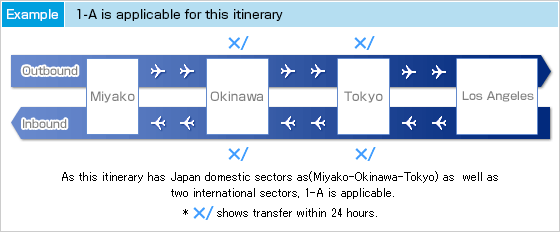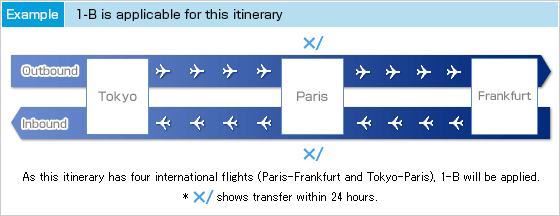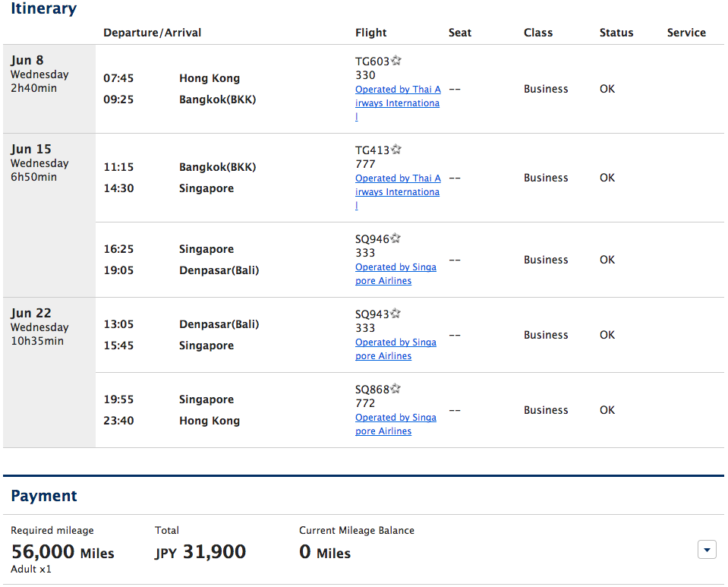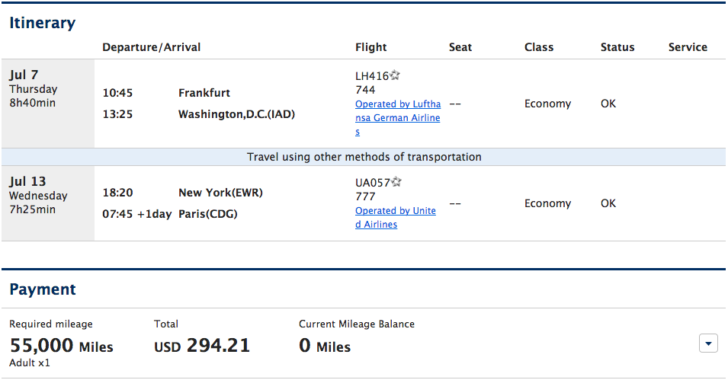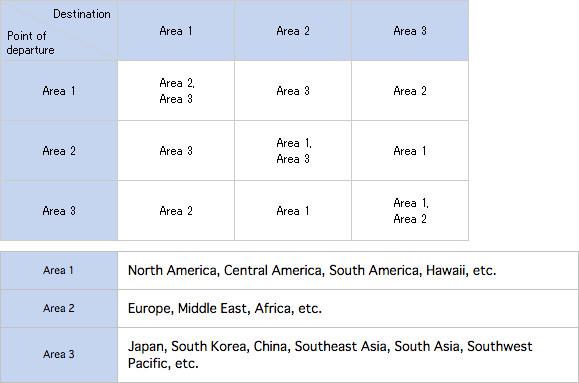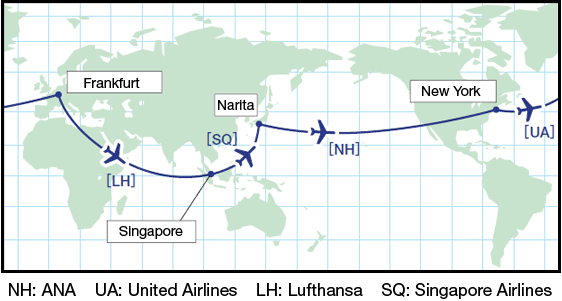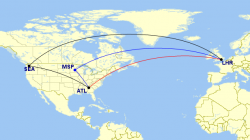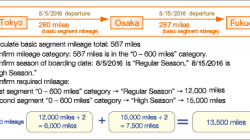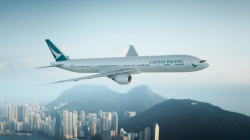ANA Mileage Club used to be a key program for those interested in booking Star Alliance awards. That was partly because of an inexpensive distance-based award chart and partly because of a very accurate search tool. These changed in 2015 with a new website and a new zone-based chart for international partner awards, while the distance-based chart continues to be used for pricing round-the-world awards. ANA also has two separate charts for travel on its own planes: a zone-based chart for international travel and a distance-based chart for domestic travel.
I think the program still deserves some attention, but it gets complicated quickly. I will explain the distinction between these four charts in more detail in my guide to booking ANA Mileage Club awards coming later this weekend. This post focuses just on the routing rules.
The ANA website actually has very detailed instructions, but my experience with Japanese websites in general is that they provide too much detail. Sometimes important information is lost in translation. I’ve done my best to distill the essential elements here.
Two Connections …Most of the Time
ANA strictly controls the number of connections permitted for most awards. Typically two connections (or “transfers”) are permitted on each roundtrip award, which means one in each direction. An example for an international partner award would be Newark to San Francisco to Hong Kong and back on United Airlines.
If booking an international ANA award, you’re still limited to two connections, and they must be within Japan. For example, Osaka to Tokyo to Singapore and back.
This information is not well explained on the main page for each award type, but you can find it in more detail if you visit the “Terms of Use” tab. For example, here is the explanation provided for international partner awards:
Up to two transfers may be made on the outbound and inbound trips each in Japan. Up to two transfers may also be made on outbound and inbound trips each other than Japan.
Note that this allows for additional connections only if you’re booking an international partner award to or from Japan. In that case, you’re allowed two domestic connections and two international connections for a total of four. It’s possible that all of these connections could be within Japan if you’re making one of those transfers to an international flight. See the example of a Zone 1-A award in the next section for a demonstration.
Most people will not have difficulty with this rule if they live near a major international gateway, but it does create complications for visiting smaller cities. Even moderately sized cities, like Seattle, do not have as many flights as larger gateways like San Francisco or Los Angeles.
If I know that I need to travel from Seattle to Singapore, I may not be able to leave directly from my home city and complete the journey with only one stop in each direction. It could make sense to buy a separate ticket to San Francisco (with cash or miles) and then book an international partner award from San Francisco to Hong Kong to Singapore, using my stop in Hong Kong. (Alternatively, I could book an award from Seattle to San Francisco to Hong Kong, using my stop in San Francisco, and then use miles or cash to buy a separate ticket from Hong Kong to Singapore.)
Zone 1-A vs. Zone 1-B
For travel to or from Japan, the number of connections will also affect the price of an international partner award. (This is not an issue for travel on ANA-operated itineraries, or for international partner awards that don’t go to Japan.)
Japan is categorized in Zone 1, which is subdivided into Zone 1-A (cheaper) and Zone 1-B (more expensive). The difference is small enough that I would not worry about it in most cases.
Your partner award can only include two international flights in order to be eligible for Zone 1-A pricing. Since all awards are round-trip, that means a non-stop flight in each direction. You are still allowed up to two connections within Japan. ANA provides this example of a Zone 1-A partner award:
If you don’t meet this requirement, then your partner award will be subject to Zone 1-B pricing. ANA provides this example of a Zone 1-B partner award:
One Stopover
A stopover differs from a connection because it allows you to visit a connecting city for a couple days or even weeks before continuing to your destination. They are a very useful tool for travelers who want to visit multiple cities without redeeming more miles. In one of the above examples, you could visit Hong Kong for a couple days before continuing to Singapore, which is your actual destination.
There is a lot of conflicting information written about how many stopovers ANA permits. Everyone’s pretty clear you’re allowed just one. But some say it has to be part of an award to Japan (not from). Others say it can only be part of an award from Japan (not to).
I’ve tested several itineraries, and it appears that all international awards allow one stopover regardless of your origin or destination — a fact first brought to my attention by the Lazy Traveler. For example, here is a stopover in Bangkok when traveling between Hong Kong and Bali. This route never touches Japan, and none of the flights are operated by ANA.
It doesn’t help that ANA’s explanation of the rules is a little vague:
One stopover, other than your destination, may be made on flights departing from Japan and overseas for either the outbound or inbound trip.
I interpret this to mean that one stopover is permitted on flights that depart Japan and on flights that depart from overseas countries. (Japan is surrounded by ocean, so that would be all of them.)
Two Open Jaws
All awards are also permitted to have an open jaw, which would mean flying into one city and returning from another. For example, you could fly into Bali and return from Bangkok (finding your own way between those cities). The open jaw can be at either the origin or the destination.
The Lazy Traveler said he was able to book two open jaws, one on each end, and I confirmed that with the following itinerary between North America and Europe:
However, I frequently got error messages when trying other itineraries. I would pick each flight, and only on the final payment page would it display an error saying the itinerary was ineligible for service. It might have been an unrelated issue specific to those flights and not the way I constructed the itinerary.
Connection Points
ANA identifies specific regions where you may connect when traveling between two other regions. Although this is similar to American Airlines, it is not nearly as restrictive. American AAdvantage lists regions from its own award chart, and unless it is expressly permitted, you can’t transit a third region.
ANA just uses the three main geographic regions of the globe known to travel agents as Area 1, Area 2, and Area 3. Because each one spans multiple continents, you shouldn’t have a problem as long as you follow a sensible path.
In practice this means you cannot transit a region other than your origin or destination. If you are departing and arriving within Area 1, for example, you may not visit Area 2 or 3. If you are departing from Area 2 and arriving in Area 3, you may not visit Area 1.
Round-the-World Awards
Round-the-world awards have several exceptions to the above rules. In particular, they are permitted eight stopovers so you can visit several cities during your journey. That’s the entire point, and to emphasize their purpose, round-the-world awards can only be used for itineraries longer than 10 days.
The restrictions on which regions you can transit do not apply. However, there are some restrictions on where stopovers may be located: only three are permitted within Europe, and only four are permitted within Japan.
These awards are actually cheaper than international partner awards in some circumstances since they are priced by distance instead of a zone-based chart. The caveat is you must travel in one direction, either east or west. You cannot travel back across the same ocean to return home. This will work well for some journeys, such as between the East Coast and Asia, for which the distance is about the same. Round-the-world awards don’t make as much sense for other journeys, like those between the U.S. and South America.


